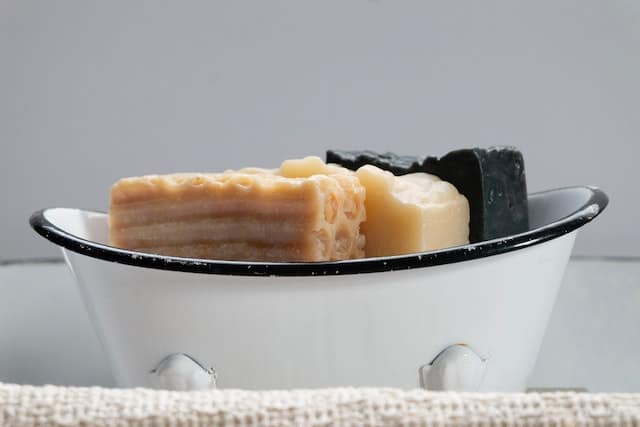Welcome to our guide on how to effectively clean a soap dish.
Keeping your soap dish clean is not only essential for maintaining proper hygiene but also contributes to the longevity of the soap and enhances the overall appearance of your bathroom.
In this article, we will provide you with easy-to-follow steps and useful tips to ensure your soap dish remains spotless and functional.
Let’s begin.
Importance of Cleaning Soap Dishes
Regularly cleaning your soap dish offers several benefits. Firstly, it prevents the growth of bacteria and germs, ensuring that the soap you use remains clean and safe for your skin.
Additionally, a clean soap dish prevents soap residue from building up, which can lead to clogged drains and unpleasant odors.
Lastly, maintaining a clean soap dish contributes to an organized and aesthetically pleasing bathroom environment.
Gathering the Necessary Supplies
Before diving into the cleaning process, gather the following supplies:
- Warm water
- Dish soap
- Sponge or soft brush
- Towel
Having these items ready will make the cleaning process efficient and effective.
Step 1: Emptying the Soap Dish
Start by removing any remaining soap bars or residue from the dish. Discard any small soap remnants and ensure the dish is empty before proceeding.
This step allows you to start with a clean slate.
Step 2: Rinsing with Warm Water
Hold the soap dish under warm running water to thoroughly rinse away loose debris. This step helps in removing any superficial dirt or soap remnants, making the subsequent cleaning process easier.
Step 3: Applying Dish Soap
Apply a small amount of dish soap onto a sponge or soft brush. Gently lather the soap dish with the soapy sponge, ensuring all areas are covered.
The dish soap helps break down stubborn residue and grime.
Step 4: Scrubbing and Removing Soap Residue
Using the sponge or brush, scrub the soap dish, paying special attention to corners, crevices, and hard-to-reach areas.
Be thorough but gentle to avoid damaging the dish. Focus on removing any soap scum and residue buildup, which can accumulate over time.
Step 5: Rinse and Dry
Thoroughly rinse the soap dish under warm water again, ensuring that all soap residue and cleaning agents are completely removed.
Proper rinsing helps maintain the soap dish’s cleanliness and prevents any soapy residue from remaining on the surface.
Once rinsed, dry the dish completely using a clean towel before placing it back in its designated spot.
Step 6: Preventing Future Buildup
To prevent future buildup, consider the following tips:
- Opt for self-draining soap dishes that allow excess water to flow away, minimizing the chances of soap scum formation.
- After each use, wipe the dish with a towel or sponge to remove excess water and soap residue.
- Avoid leaving wet soap bars on the dish for extended periods as this can lead to sticky residue buildup.
Tips for Effective Soap Dish Cleaning
Here are some additional tips to ensure effective soap dish cleaning:
- For stubborn stains, consider using white vinegar. Apply vinegar to the soap dish, let it sit for a few minutes, then scrub and rinse as usual.
- Periodically deep clean your soap dish by sprinkling baking soda on a damp sponge or brush. Scrub the dish gently to remove any tough residue.
- Avoid using abrasive cleaners or harsh chemicals, especially on delicate materials like ceramic or glass, as they can damage the soap dish.
Common Mistakes to Avoid
To achieve the best results, avoid the following common mistakes when cleaning your soap dish:
- Using harsh chemicals or bleach that can damage the soap dish’s material or color.
- Scrubbing too forcefully can scratch or damage the dish.
- Neglecting regular cleaning routines, allowing soap scum and residue to accumulate over time.
Conclusion
Maintaining a clean soap dish is a simple yet essential part of bathroom cleanliness and organization.
Regular cleaning not only promotes good hygiene but also extends the lifespan of your soap dish, keeping it functional and visually appealing.
By incorporating these cleaning practices into your routine, you can enjoy a clean and inviting bathroom space while keeping your soap fresh and ready for use.
Are you interested in learning some natural home degreaser recipes? Read Homemade Degreaser: 4 Simple and Effective Recipes.
Frequently Asked Questions
FAQ 1: How often should I clean my soap dish?
We recommend cleaning your soap dish at least once a week or as needed, depending on the frequency of soap usage and residue buildup. Regular cleaning helps maintain optimal hygiene and prevents soap scum from accumulating.
FAQ 2: Can I use bleach to clean a soap dish?
It’s best to avoid using bleach as it can potentially damage or discolor certain soap dish materials. Instead, opt for mild cleaning agents like dish soap or vinegar to ensure the longevity and appearance of your soap dish.
FAQ 3: What if my soap dish is made of delicate material?
If your soap dish is made of delicate materials like ceramic or glass, take special care when cleaning. Use a soft sponge or cloth and avoid abrasive scrubbing to prevent any damage to the dish’s surface.
FAQ 4: Is it necessary to clean a self-draining soap dish?
Yes, even self-draining soap dishes require regular cleaning. While these dishes allow water to drain away, soap residue can still accumulate over time. Follow the cleaning steps mentioned in this article to ensure a clean and hygienic soap dish.
FAQ 5: Can I clean a soap dish in the dishwasher?
It is not recommended to clean a soap dish in the dishwasher. The high heat and harsh detergents used in dishwashers can potentially damage certain materials. Hand cleaning using the outlined steps will yield the best results while keeping your soap dish in excellent condition.
Photo by Sydnee More from Pexels

